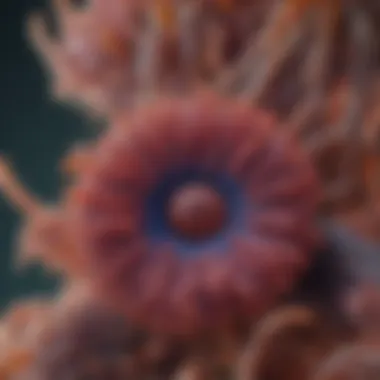Understanding Melioidosis: Symptoms and Clinical Insights


Overview of Research Topic
Brief Background and Context
Melioidosis is an infectious disease caused by the bacterium Burkholderia pseudomallei. This pathogen is typically found in tropical and subtropical climates, making it more common in regions such as Southeast Asia and Northern Australia. The modes of transmission vary; it can occur through direct contact with contaminated water or soil, inhalation, or ingestion. Understanding this disease is crucial, as it presents a broad spectrum of clinical manifestations, from asymptomatic to severe systemic illness.
Importance in Current Scientific Landscape
The significance of studying melioidosis has escalated as global climate changes can alter the geographic spread of Burkholderia pseudomallei. Healthcare systems, especially in endemic areas, must be prepared for the potential increase in cases, necessitating early detection and effective treatment methods. Moreover, researchers are focused on improving awareness about the disease, its risk factors, and potential complications.
Methodology
Research Design and Approach
This article synthesizes current literature from clinical studies and reviews regarding melioidosis, emphasizing its symptoms and clinical insights. A systematic approach is applied to analyze the ranges of symptoms documented, evaluating their onset and severity in different patient populations.
Data Collection Techniques
Data were collected from peer-reviewed articles, clinical trials, and health reports. A combination of qualitative and quantitative research methods allowed for an in-depth understanding of symptomatology related to melioidosis. These resources help in providing a clearer insight for healthcare professionals on diagnosis and management of the disease.
Preamble to Melioidosis
Melioidosis, caused by the bacterium Burkholderia pseudomallei, poses significant health risks, especially in tropical and subtropical regions. Understanding this disease's foundations is crucial for recognizing its implications and facilitating early diagnosis. Given its often severe and diverse manifestations, awareness about melioidosis can equip healthcare professionals and the public with the necessary tools for effective management and intervention. The importance of understanding melioidosis cannot be overstated, as it directly relates to healthcare practices and public health initiatives aimed at combating infectious diseases.
Definition of Melioidosis
Melioidosis is an infectious disease linked to the bacterium Burkholderia pseudomallei, primarily found in soil and water. It can affect a wide range of individuals, particularly those with underlying health conditions or compromised immune systems. The infection can manifest in various forms, ranging from mild to severe symptoms that can lead to significant morbidity and mortality. Understanding the precise definition and nature of this disease is vital for effective clinical attention and public health discussions.
Epidemiology and Transmission
Geographic distribution
The geographic distribution of melioidosis chiefly points to climates that provide suitable conditions for Burkholderia pseudomallei to thrive, such as tropical and subtropical regions. Countries in Southeast Asia and northern Australia report the highest incidence rates. The unique feature of Burkholderia pseudomallei is its ability to persist in the environment, leading to endemic regions where melioidosis is prevalent. The relevance of this distribution lies in understanding where interventions can be most effective and why this disease garners more attention in specific areas. Public health efforts can thus be tailored to address the specific needs of these regions.
Routes of infection
Infection with Burkholderia pseudomallei can occur through various routes. The most common transmission occurs via skin contact, inhalation of contaminated droplets, or ingestion of contaminated water or food. The key characteristic of these routes is that they can occur without direct person-to-person contact, making melioidosis a challenging disease to control. This aspect emphasizes the importance of environmental hygiene and personal protective measures in regions prone to this bacterium. Each route's unique features underscore the complexity of preventing melioidosis, requiring targeted public health strategies aimed at minimizing exposure in the affected areas.
Pathophysiology of Melioidosis
Understanding the pathophysiology of melioidosis is crucial for healthcare professionals. It provides insights into how Burkholderia pseudomallei interacts with host organisms. Comprehending this interaction helps in diagnosing, treating, and preventing the disease. A thorough knowledge of the bacterium's characteristics and the host's immune response is essential for effective management of melioidosis.
Bacterium Characteristics
Burkholderia pseudomallei structure
Burkholderia pseudomallei is a gram-negative bacterium, which possesses a complex structure that plays an important role in its pathogenicity. The outer membrane of B. pseudomallei contains lipopolysaccharides, which can induce strong immune responses. This characteristic enhances the bacterium's survival in the host. The bacterium is also rod-shaped and motile, due to the presence of flagella, which aids its movement through mucosal surfaces.
This structural complexity makes B. pseudomallei a formidable pathogen. Its ability to evade immune detection contributes to severe pathogenesis. The robustness of its structure suggests that understanding its characteristics is beneficial for developing targeted treatments and efficient diagnostic methods.
Growth conditions
B. pseudomallei thrives in moist, tropical environments. It has a unique adaptability that allows it to survive in diverse conditions. This bacterium can grow in soil and water, which makes environments such as rice paddies and wetland areas prime sites for exposure. Additionally, it can persist in varied nutrient conditions, including negligible oxygen levels.
This adaptability is a significant factor in the geographic distribution of melioidosis. Knowledge about these specific growth conditions helps health organizations formulate strategies to reduce exposure, especially in at-risk populations.
Host Response Mechanisms
Immune response


The immune response to B. pseudomallei infection involves both innate and adaptive immunity. Initial responses are mediated by phagocytes, which attempt to engulf and eliminate the bacteria. However, B. pseudomallei has evolved mechanisms to escape phagocytosis and replicate within immune cells, leading to chronic infection.
This immune evasion strategy highlights the complexity of the immune response. Understanding these mechanisms can inform the development of immunotherapies or vaccines. Identifying the factors that enhance or inhibit the immune response is vital for improving patient outcomes.
Factors influencing susceptibility
Several factors influence an individual's susceptibility to melioidosis. Chronic conditions such as diabetes, liver disease, and renal impairment significantly increase risk. Additionally, environmental factors such as exposure to contaminated water or soil also play a role in risk assessment.
Recognizing these susceptibility factors allows for targeted public health interventions. Risk reduction strategies can be tailored to at-risk populations by focusing on both personal health and environmental exposure. This understanding is essential for effective prevention and control of melioidosis.
Common Symptoms of Melioidosis
Understanding the common symptoms of melioidosis is significant because symptoms can vary widely and may influence early diagnosis and treatment. Being aware of these symptoms allows healthcare professionals to differentiate melioidosis from other infectious diseases. The complexity and diversity in symptom presentation necessitate a clear understanding for effective clinical management. In turn, this can lead to timely interventions that can vastly improve patient outcomes.
Acute Form Symptoms
Fever and chills
Fever and chills are often the first symptoms observed in patients suffering from the acute form of melioidosis. These symptoms indicate an underlying infection and are a key diagnostic marker. The presence of fever usually signifies an immune response, whereby the body attempts to fight off the invading bacteria. Recognizing fever and chills early on can lead to more rapid diagnostic methods, which is beneficial for patient care.
The key characteristic of fever is temperature elevation, typically exceeding 38 degrees Celsius. Chills often accompany this, indicating systemic distress. This symptom's importance lies in its ability to prompt investigations into possible infections, including melioidosis.
However, it is essential to note that fever and chills can be common to various infectious diseases, causing potential misdiagnosis. Thus, these symptoms, while crucial, must be seen in the context of other symptoms and diagnostic procedures.
Cough and respiratory distress
Cough and respiratory distress represent another important aspect of acute melioidosis symptoms. Respiratory involvement can be severe, leading to complications such as pneumonia or lung abscesses. The emergence of a cough, particularly if productive of sputum, is critical in assessing respiratory function and the associated disease severity.
This symptom is notable because it reflects the direct impact of Burkholderia pseudomallei on lung tissue. The uniqueness of a productive cough in the acute setting often sets melioidosis apart from other infections that may cause similar respiratory distress. While cough and respiratory distress can lead to a sense of urgency in treatment, they also pose a diagnostic challenge since they can mirror symptoms of many respiratory diseases, complicating a definitive diagnosis.
Chronic Form Symptoms
Weight loss
Weight loss is a common symptom in the chronic form of melioidosis and may emerge gradually over time. Patients often report a lack of appetite and subsequent weight loss that can be quite significant. This symptom can have a profound impact on quality of life and overall health.
A key characteristic of weight loss in this context is its slow, progressive nature, making it sometimes overlooked as a primary concern. Tracking changes in weight can provide valuable information about disease progression and nutritional status, hence its relevance.
The unique feature of weight loss is that it can symbolize chronic illness, requiring ongoing medical attention. In some cases, it may lead to muscle wasting and weakened immune response, posing additional risks for patients.
Fatigue and malaise
Fatigue and malaise are pervasive in chronic melioidosis and can significantly hinder daily activities and productivity. Patients frequently describe an overwhelming sense of tiredness, often unrelated to physical activity, which can complicate recovery.
This symptom is critical because it reflects the body's ongoing struggle against chronic infection. The key aspect of fatigue in chronic conditions like melioidosis is its persistence, often lasting weeks or months. Multi-dimensional factors such as psychological stress can also exacerbate feelings of malaise, presenting a complex weave of symptoms.
Recognizing fatigue allows for better patient management. However, it poses challenges since it is non-specific as a symptom and can often be attributed to various other health issues.
Localized Infections Symptoms
Abscess formation
Abscess formation can occur in various body parts and is a distinctive symptom of localized melioidosis infections. When Burkholderia pseudomallei infects tissues, it tends to create pus-filled cavities, which can lead to significant clinical concerns.
The key characteristic of abscess formation lies in the localized swelling accompanied by tenderness and fever. Its identifiable nature makes it easier for healthcare providers to suspect melioidosis during examination. In addition, the location of abscesses can guide treatment strategies by indicating how the infection has spread.
Nonetheless, while abscesses can be diagnosed through physical symptoms, imaging, and culture tests, the challenge remains in managing pain and potential complications that arise due to their presence.
Bone and joint pain


Pain in the bones and joints also emerges as a symptom of melioidosis and can often be misinterpreted. Such pain typically relates to osteomyelitis or septic arthritis, which may occur in the later stages of infection.
The key characteristic of bone and joint pain is its often severe and debilitating nature, which can significantly affect mobility. Recognizing this symptom is vital, as it emphasizes the systemic impact of melioidosis and raises the suspicion for further investigation.
However, it is important to understand that pain can vary from mild weakness to intense discomfort, affecting individuals differently. This variability adds to the complexity of diagnosing melioidosis, requiring careful clinical evaluation and follow-up.
Recognition and Diagnosis
Recognition and diagnosis of melioidosis is a critical component in the effective management of this complex infectious disease. Early detection can be invaluable for improving patient outcomes. Melioidosis can mimic various other conditions, making it necessary for healthcare professionals to possess a keen awareness of its signs and symptoms. Misdiagnosis can lead to inappropriate treatments and worsen patient prognoses. This section will detail the clinical diagnosis procedures and laboratory confirmation techniques that significantly contribute to identifying melioidosis.
Clinical Diagnosis Procedures
History-taking
History-taking is an essential part of the clinical diagnosis process. It encloses collecting detailed patient backgrounds, including symptoms, possible exposures, and travel history. A thorough history allows clinicians to layout a connecting puzzle of the patient’s health status. The key characteristic of history-taking is the comprehensive understanding it provides healthcare workers regarding the patient’s condition. This process involves asking specific, targeted questions that can uncover significant information relevant to melioidosis, such as prior travel to endemic regions or contact with contaminated soil or water.
One beneficial aspect of history-taking is its ability to highlight risk factors associated with melioidosis, aiding in faster recognition of the disease. However, its unique feature lies in its reliance on accurate patient recollection, which may sometimes lead to incomplete information. In cases where patients are unsure or unable to elaborate, it may lead to challenges in making a prompt diagnosis.
Physical examination findings
Physical examination findings form another critical aspect of clinical diagnosis. This entails assessing the patient for specific signs associated with melioidosis, such as fever, lung sounds, or soft tissue swelling. The key characteristic of physical examination findings is their capability to provide real-time, observable data regarding the individual's health. A clinician can quickly assess whether a patient's condition aligns with common manifestations of melioidosis.
The primary advantage of physical examination is the immediate feedback it offers about the patient's health status. However, the uniquely challenging aspect is that some patients may have atypical presentation of symptoms, leading to potential misinterpretations. Thus, relying solely on physical examination findings without the support of history-taking or subsequent tests can sometimes yield inconclusive results.
Laboratory Confirmation
Laboratory confirmation plays an imperative role in diagnosing melioidosis. Once suspicion arises through clinical procedures, definitive testing is essential to confirm the presence of Burkholderia pseudomallei.
Culture methods
Culture methods for identifying Burkholderia pseudomallei are a fundamental diagnostic tool. This process involves isolating the organism from various specimens, including blood, sputum, or tissue samples. The key characteristic of culture methods is their specificity and reliability. They can substantiate diagnosis, providing robust confirmation of the bacterium's presence.
The unique feature of culture methods is the ability to observe how the pathogen grows under laboratory conditions. This can aid in understanding how the organism behaves, which may influence treatment decisions. Nonetheless, culture methods may have longer turnaround times, which can delay diagnosis and initiation of appropriate treatment.
Serological tests
Serological tests are also crucial in establishing a diagnosis of melioidosis. These tests detect antibodies to Burkholderia pseudomallei in the patient's serum. The key characteristic of serological tests is their ability to provide rapid results, which can be critical in acute settings. When time is of the essence, serological tests can quickly indicate if a patient has been exposed to the bacterium.
One unique feature of serological tests is that they may also reveal cross-reactivity with other infections, potentially complicating interpretation. This limitation necessitates the results to be evaluated in conjunction with clinical findings and culture results for accurate diagnosis.
Accurate recognition and diagnosis of melioidosis is essential for effectively guiding treatment and improving patient outcomes.
In summary, understanding the recognition and diagnosis of melioidosis underscores the need for comprehensive history-taking, physical examination, and reliable laboratory confirmation. This multi-faceted approach is vital for timely identification and management of the disease.
Differential Diagnosis
Differential diagnosis is crucial when assessing melioidosis, as its symptoms can resemble those of various other conditions. Proper differentiation can lead to timely treatment, preventing complications and severe outcomes. Understanding conditions that share similar presentations ensures that healthcare providers do not overlook melioidosis, particularly in endemic regions where its prevalence is notable.
Recognizing the uniqueness of each condition is vital to refining the diagnostic process. It helps in pinpointing the exact illness affecting the patient. It prevents the misdiagnosis that can lead to inappropriate management strategies. Knowledge of similar conditions also aids in the identification of risk factors and comorbidities that may influence disease severity.
Conditions with Similar Symptoms
Sepsis
Sepsis is often considered in the differential diagnosis of melioidosis due to overlapping symptoms. It arises when the body responds aggressively to an infection, leading to systemic inflammation. The typical symptoms include fever, chills, rapid heart rate, and difficulty breathing. Notably, sepsis can manifest shortly after the initial infection flares up, similar to the abrupt onset seen in acute melioidosis.
The key characteristic of sepsis is its potential for rapid progression. This can be beneficial for clinicians, as the urgency of treatment elevates awareness among healthcare professionals. However, a unique feature of sepsis is its broader spectrum of causative organisms. While melioidosis is specific to Burkholderia pseudomallei, sepsis can result from various pathogens. Hence, although the approaches may overlap, the management strategies differ significantly.
Other Tropical Infections


Other tropical infections also share symptomatology with melioidosis. Diseases such as typhoid fever, leptospirosis, and dengue can produce similar clinical features, including fever, malaise, and gastrointestinal symptoms. The resemblance can lead to diagnostic challenges in areas where multiple tropical diseases co-exist, necessitating a thorough evaluation of travel history and exposure risk.
The key characteristic of other tropical infections is their geographical distribution. This makes them important considerations in regions where melioidosis is endemic. They can often complicate the clinical picture, as patients may have co-infections. The unique feature here is the variety of causative organisms and modes of transmission, which can influence treatment efficacy.
In summary, recognizing these conditions—sepsis and other tropical infections—is essential in the differential diagnosis process for melioidosis. Understanding the distinctions and overlaps enhances the clinician's ability to provide precise treatment. Furthermore, thorough differential diagnosis reduces the risk of mismanagement, particularly in patients whose health can decline rapidly without appropriate intervention.
Public Health Implications
The public health implications of melioidosis are significant due to the disease's potential for outbreaks and its impact on vulnerable populations. Understanding these implications is essential for healthcare providers, policymakers, and researchers. Effective management of melioidosis is crucial as it can significantly alter health outcomes in endemic regions. The complexity of the disease's transmission and the serious illness it can cause underscore the need for comprehensive public health strategies.
Preventive Measures
Avoiding exposure
Avoiding exposure to Burkholderia pseudomallei, the bacterium responsible for melioidosis, is a fundamental preventive measure. It is particularly beneficial in tropical and subtropical regions where the disease is most prevalent. Key characteristics involve educating individuals about the environments conducive to exposure, such as wet, muddy soil and stagnant water, which are common in agricultural areas.
This strategy is a beneficial choice because it directly addresses the root of transmission. Unique features include community engagement in sanitation practices and soil management, which can lower risk levels. However, the disadvantages may encompass resistance from communities who see these practices as invasive or impractical.
Vaccination research
Vaccination research represents a promising avenue for reducing melioidosis incidence. The focus is on developing effective vaccines that target Burkholderia pseudomallei. The key characteristic of this research is its goal of preemptively protecting at-risk populations. This is particularly advantageous in places where the disease is endemic.
A unique feature of vaccination efforts lies in using genetic and molecular techniques, which may enhance vaccine effectiveness. Nevertheless, challenges exist, including the time and resources required to develop a safe and effective vaccine and the potential for varying responses among diverse populations.
Global Health Initiatives
Surveillance programs
Surveillance programs play a critical role in tracking melioidosis cases and outbreaks. These initiatives contribute significantly to public health goals by providing data that informs prevention and response strategies. A key characteristic of these programs is their ability to identify trends and potential outbreaks quickly, which is vital for timely interventions.
Moreover, the unique feature of comprehensive surveillance is its integration with local healthcare systems, enhancing real-time data collection and response capabilities. However, resource constraints in many regions can hinder the effectiveness of these programs, leading to gaps in data and missed opportunities for early intervention.
Education and awareness efforts
Education and awareness efforts are essential components of public health strategies aimed at reducing melioidosis cases. These initiatives focus on informing communities about the risks associated with melioidosis and the ways to reduce exposure. A key characteristic is the tailoring of messages to local populations, considering cultural and environmental factors.
The unique feature of these education efforts often involves collaboration with local leaders and health workers to ensure the information is accessible and actionable. Despite their advantages, challenges include the need for sustained engagement and the variability of information retention in diverse communities.
Effective public health initiatives demand a multi-faceted approach, integrating education, surveillance, and research across communities affected by melioidosis.
These public health implications highlight the balancing act required to address melioidosis effectively. The evolving nature of this disease necessitates continued research and adaptation of strategies to improve outcomes.
Ending
Melioidosis represents a significant public health challenge due to its complex nature and severe clinical manifestations. Understanding the symptoms and implications of this disease is crucial for timely diagnosis and treatment. Health professionals must remain vigilant in recognizing the symptoms which can present in varied forms, including acute, chronic, and localized infections.
Key elements to note include:
- The diverse symptomatology associated with melioidosis, which can easily be mistaken for other infections.
- The importance of rapid diagnostic methods to enhance treatment outcomes.
- The need for healthcare education and awareness to prevent outbreaks, especially in endemic regions.
This article provides detailed insights into these aspects, assisting healthcare workers in recognizing the illness promptly. It also highlights the potential for serious complications if treatment is delayed. Regarding benefits, a well-informed approach towards melioidosis can save lives and reduce morbidity, making this discussion imperative.
"Early diagnosis and therapy of melioidosis are fundamental for survival, particularly with regard to severe cases."
Summary of Key Points
In summarizing the key points of this article:
- Melioidosis is caused by the bacterium Burkholderia pseudomallei, primarily infecting those in tropical climates.
- Symptoms are varied, including acute respiratory distress as well as chronic fatigue.
- Accurate diagnosis hinges on strong clinical judgment, combining patient history and laboratory tests.
- Differentiating melioidosis from other conditions such as sepsis and other tropical diseases is crucial.
- Preventive measures can significantly reduce incidence, emphasizing education and awareness initiatives.
Future Research Directions
Future efforts in melioidosis research should focus on:
- Developing vaccines to reduce incidence in high-risk populations.
- Expanding surveillance programs for more effective tracking of infection rates and outbreaks.
- Investigating the molecular characteristics of Burkholderia pseudomallei to enhance diagnostic tests.
- Exploring the host response mechanisms to identify factors that contribute to the severity of the disease.
- Considering international collaborations for a global perspective on prevention and treatment strategies.
Continued exploration and understanding of melioidosis will empower healthcare professionals, researchers, and public health officials to devise methods that better control and prevent this disease.



